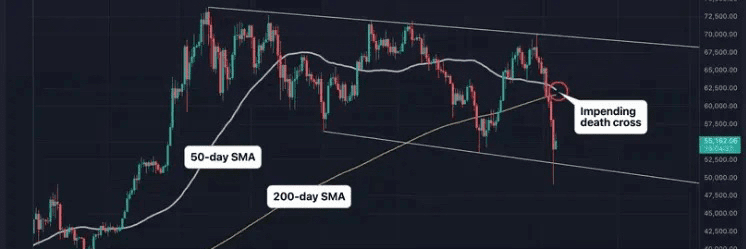Indicators like the death cross are inherently lagging and offer limited predictive power.
* Bitcoin price is staring at a death cross, a pattern that trapped bears on the wrong side of the market last September.
* BTC’s near-term outlook is closely tied to the health of the U.S. economy and the volatility of the Japanese Yen.
Some indicators are inherently lagging and offer limited predictive power, yet they consistently make headlines in both traditional and crypto markets, often causing unnecessary panic among inexperienced investors.
One such example is the Bitcoin (BTC) death cross, which tends to trigger high levels of fear and impulsive reactions on social media despite its poor record in accurately predicting future price trends. So get ready, because one appears to be on the way.
A death cross occurs when the 50-day simple moving average (SMA) of an asset’s market price falls below the 200-day SMA. Currently, the 50-day SMA of Bitcoin price is $62,332 and falling, indicating a possible crossover with the 200-day SMA at $61,605.
This development was widely interpreted as a bearish signal and led to catastrophizing — a cognitive distortion that prompts inexperienced traders to draw the worst conclusions given limited information and understanding. Overreaction is typical, especially when sentiment has already deteriorated, such as in the BTC market. The cryptocurrency fell more than 20% in a week to $55,000, according to CoinDesk.

In reality, the chart pattern only shows the nature of price action over the last 50 days. It does not guarantee that future action will be in the same direction.
The last death cross, confirmed on September 12, 2023, was a major bear trap. BTC bottomed out at $24,900 on the same day and never looked back, eventually reaching an all-time high of over $70,000 in March of this year. Investors who were expecting further declines were left out.
As CoinDesk discussed last year, the previous nine death crosses had a mixed record, with only five of them signaling a long-term downtrend.
All in all, the death cross is unreliable as a standalone indicator. Bitcoin’s near-term outlook depends largely on U.S. economic data and the volatility of the Japanese yen. Continued demand for the yen in the foreign exchange market could further weaken carry trades and weigh on risk assets, including Bitcoin.
The upcoming crossover indicates that short-term momentum, represented by the 50-day moving average, is underperforming its long-term average.
